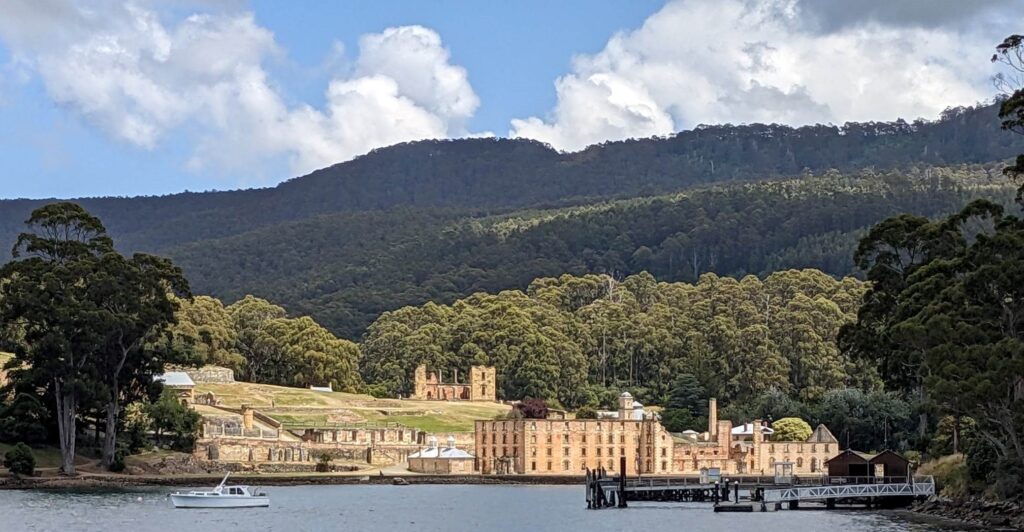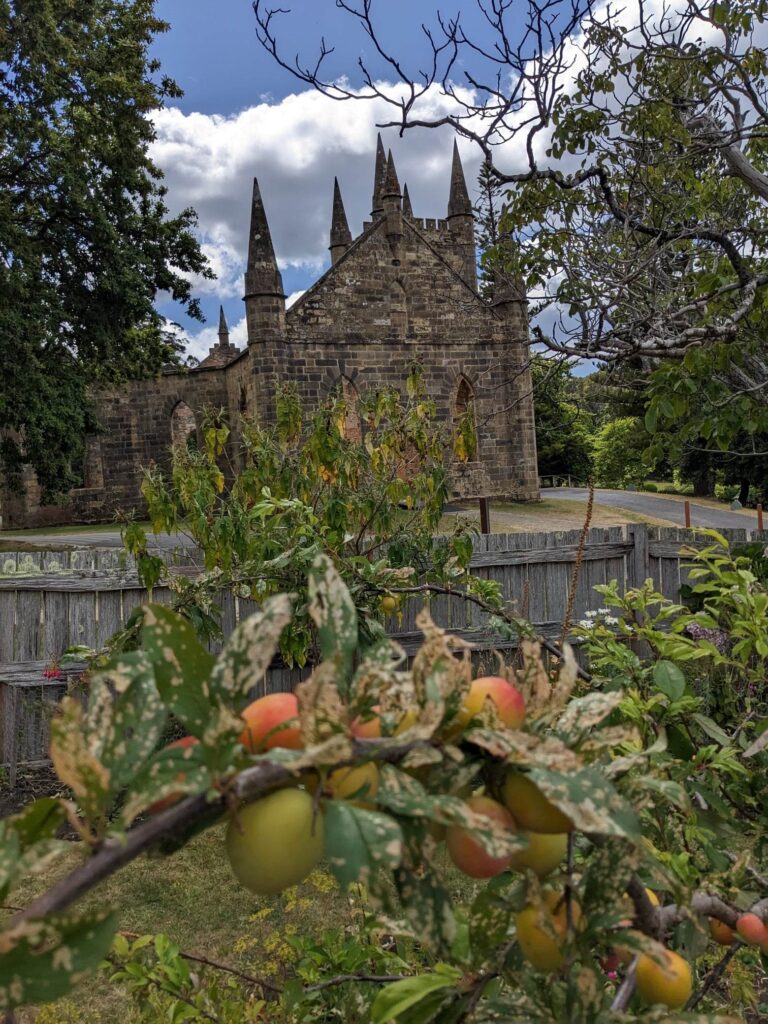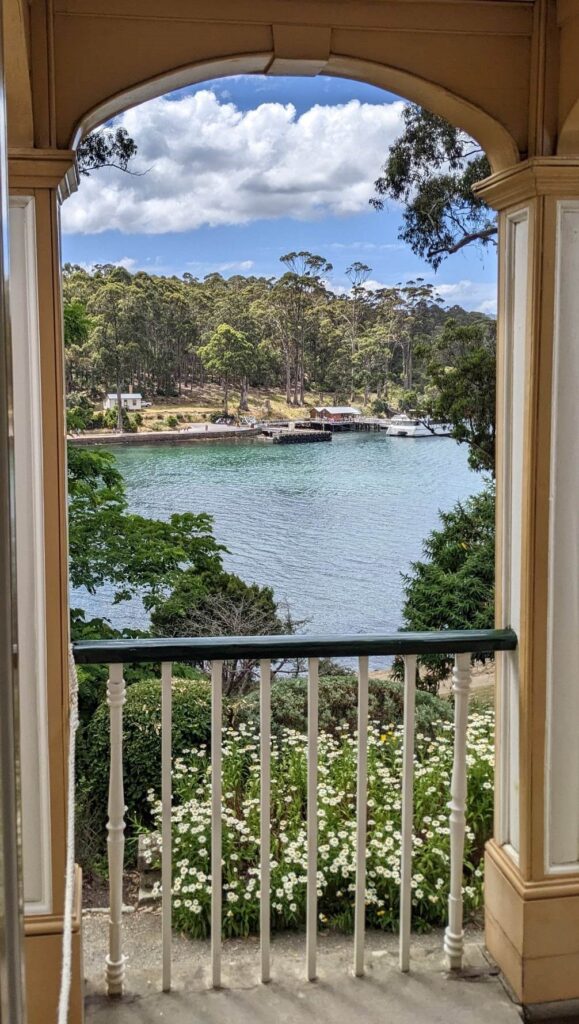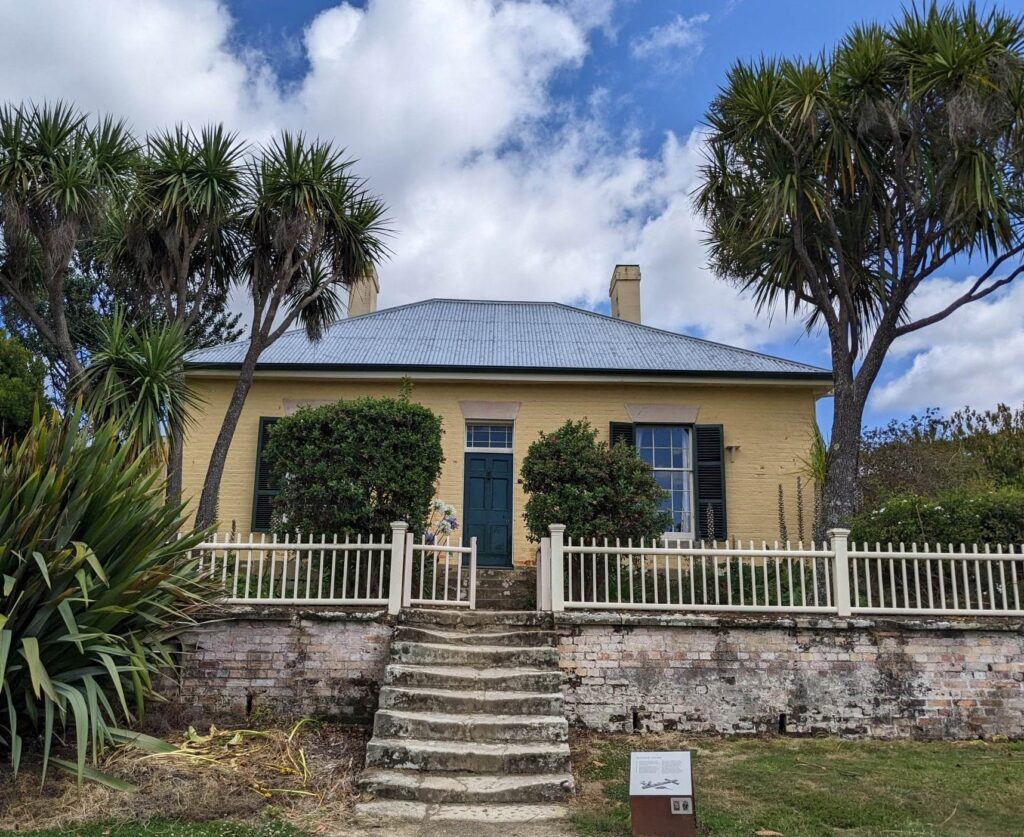
Port Arthur. Today, it is an hour and a half’s drive from the pretty, waterside city of Hobart. Two hundred years ago, it was a day’s sailing from the decidedly seedy and often violent waterfront of Hobart Town, which had already developed a bad reputation for bawdy behaviour and violence, as visiting sailors and ex-convicts gravitated to the pubs, brothels, and gambling houses for cards and cock fighting.
These days, Port Arthur is an attractive, peaceful outdoor museum. Fifty acres of lawn and pretty gardens, brick and weatherboard houses, the remains of a hospital, a garrison, a lunatic asylum, a church. Fire has damaged many of the original buildings, but their presence can still be felt, in the arched doorways and decorative stone carvings of the church, in the bars on the empty windows of the penitentiary, in the watch tower below the ruins of the garrison. For back then, Port Arthur was a prison for hardened criminals and repeat offenders.
The penal settlement at Port Arthur was established in 1830 by the Lieutenant Governor of Van Diemen’s Land, later to be known as Tasmania. For almost half a century, thousands passed through its gates – and not only convicts, but the soldiers sent to guard them, priests to pray for them and a handful of civilians: doctors, accountants, teachers and their families.
On a sunny day, the plethora of ghostly inhabitants at Port Arthur are shadowy, invisible to the naked eye. Only the scattered information plaques remind us that here dwelt real people, individuals with their own stories to tell, not merely historical profiles or a nameless hoard of mad and dangerous criminals. Many of these men were unemployed veterans of the Napoleonic Wars, or unwitting victims of Britain’s industrial revolution. Forced to relocate from tenant farms to smog-ridden and stinking city slums, many found only unemployment and starvation. Stealing became a means of survival in a harsh environment, as any reader of Charles Dickens will be aware. Around half of those who ended up in Van Diemen’s Land already had a trade or skill useful to the new colony, and were given the opportunity to work off their sentences in meaningful employment, and not necessarily behind bars. Others were forced onto chain gangs; slave labour sent out to build the foundations of our ‘new’ world, in the form of roads and bridges, and even their own prison buildings.
Historians have worked to retrieve some of these individual stories. ‘Pack of Thieves?’ tells the tales of fifty convicts sent out to Port Arthur in the 1830s, in an attempt to differentiate a small, random selection of men and boys from the morass of disease-ridden, sullen and vicious prisoners, herded into dank sailing ships and deported to the ends of the earth for the terms of their natural lives. Some got a second chance, others ended their days covered in welts inflicted by the cat-o-nine-tails, or mentally deranged by their experiences of isolation and exile.
By 1840, Port Arthur was home to around 2000 people: convicts, soldiers and civilians. For almost half a century this multifarious community of misplaced Britons dwelt at the end of the earth. The prison was finally closed in 1877, but it has been a site of historic interest since 1916 and was listed as a World Heritage Site in 2010.
Today, it is a fascinating place to spend a day or two, learning about Australia’s convict past, exploring the houses of the resident civilians, and imagining the isolation of a penal colony more than thirteen thousand nautical miles from home. Ensconced in my comfortable life, picnicking by the quay, a stone’s throw from a cafeteria and a gift shop, it is almost impossible to put myself in the shoes of Benjamin Stanton who, only fifteen, and undoubtedly cold, stole a coat. Or John Jones, convicted to transportation for life for stealing a shirt, previously imprisoned for vagrancy. Foul language and several escape attempts led to months in chains and fifty lashes. It seems that the myth of exile for stealing a loaf of bread is in fact only a hair’s breadth from the truth. Many of these convict tales speak of petty theft, and an underlying urgency to survive.
Perhaps easier for me to envision, is the isolation thrust upon the women in the colony who accompanied their husbands to this far flung island. Innocent of any crime, they had nonetheless been torn from their comfortable lives and families in Britain, and flung upon a largely male community, with its garrison full of soldiers and its prison full of convicted felons. Any staff they employed were likely also to be criminals; women brought from the ‘female factory’ in Hobart. One governess was reported to be drunk and disorderly, and was promptly dismissed. But who could blame her, stuck in no man’s land, neither gentry nor convict? She must have been as lonely as hell, her social isolation almost as complete as those men removed to the ‘Separate Prison’. This new model of psychological torture for recalcitrant prisoners forced them to live in tiny cells, silent and nameless, reduced to a mere number on a door, their isolation completed by a mask when they emerged for a daily, solitary, hour of fresh air. Here, they were supposed to contemplate their crimes for 23 hours a day, although they were also provided with tasks such as sail-making or shoemaking. Meanwhile, the rest of the inmates were housed in the penitentiary, a converted flour mill that accommodated about five hundred men in cells or dormitories.
Across the cricket pitch from the garrison and the penitentiary is a small village, within walking distance to the Church. Attending services on Sundays was compulsory, presumably for the civilians as well as their convict neighbours. Some of these houses have been furnished in the style of the era, and it is a fascinating trip through time to find yourself in the accountant’s kitchen listening to ‘Dad & Dave’ on the radio.
After our picnic lunch, a catamaran takes us out into the bay to see the Isle of the Dead, a rocky outcrop that became the burial place for more than 1000 Port Arthur residents. Yet, even in death there is a hierarchy. While free men, women and children lie on the higher side of this island graveyard, often with elaborate headstones, the convict dead were planted at the bottom of the slope, in unmarked graves.
Opposite the cemetery, is The Point Puer Boys’ Prison, the first separate boys’ prison in the British Empire, renowned for its stern discipline and harsh punishment. Three thousand boys were imprisoned here between 1834 and 1849, some as young as nine years old. For it seems that under English common law, the minimum age of criminal responsibility was only seven years old. Most of these children were put to work cutting the stone to build the church and houses across the bay at the main penal settlement.
Steve Harris has written a book about the transportation of these boys; the juvenile male prisoners shipped to Australia ‘on an industrial scale’ and brutally treated. The Lost Boys of Mr Dickens is a confronting read, even when only flicking through it, but it really brings the horrors of this now peaceful and beautiful setting to life.
*Thanks again to the One & Only for his superior photography.



